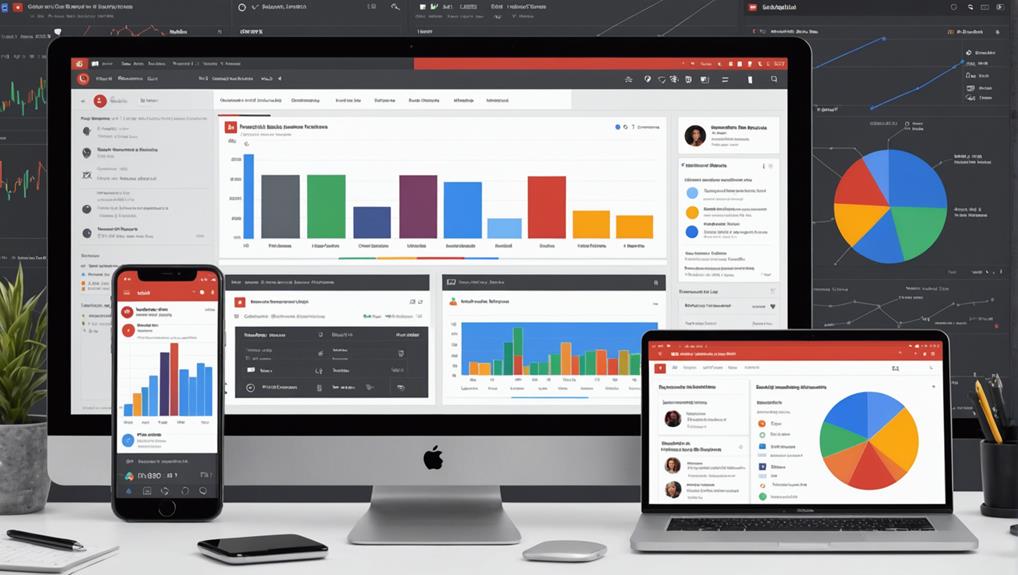Understanding how different traffic sources contribute to your YouTube channel's performance is essential for strategic growth and audience engagement. Analyze metrics like watch time, views, and click-through rates from sources such as YouTube search, suggested videos, and external sites. Effective optimization for search engines includes using impactful keywords and high-quality thumbnails. Look at direct sources to gauge brand loyalty and external sources to expand your reach. Each source offers unique insights into audience behavior, driving data-driven decisions for your content strategy. Keep tracking these metrics to refine your approach and reveal deeper insights into enhancing your channel's performance.
Key Takeaways
- Analyzing traffic sources helps optimize content for search engines and suggested videos, boosting visibility and engagement.
- Direct sources highlight core audience engagement and brand loyalty, offering insights into dedicated viewers.
- External sources drive additional traffic from social media and websites, expanding the channel's audience base.
- High watch time and click-through rates from various sources indicate effective audience interest and content alignment.
- Utilizing YouTube Analytics to track traffic sources informs strategic decisions for content creation and promotional efforts.
Types of YouTube Traffic Sources
Understanding the various types of YouTube traffic sources is essential for optimizing your channel's growth strategy. YouTube search, suggested videos, direct or unknown sources, external sources, and playlist and channel pages each play a unique role in driving traffic to your content.
When viewers find your videos through YouTube search, it often indicates strong alignment with their search intent, leading to higher engagement rates and viewer retention. Analyzing audience demographics and viewer behavior here can help you tailor your content to match what searchers are looking for.
Suggested videos capitalize on YouTube's algorithm to recommend your content based on viewers' browsing history and preferences. This source can greatly boost your channel's growth if your videos are consistently engaging, as it taps into an already interested audience.
Direct or unknown sources involve viewers who directly access your video or whose sources can't be identified, often indicating strong brand loyalty. Monitoring engagement rates and viewer retention from this source can provide insights into your core audience.
External sources bring traffic from outside platforms like social media or websites. By understanding the audience demographics and viewer behavior of these external viewers, you can refine your off-YouTube marketing strategies for better reach and engagement.
Analyzing YouTube Analytics
To effectively analyze your YouTube Analytics, start by examining key metrics like watch time, views, and click-through rates.
Focus on the Traffic source types section to understand where your views are coming from, whether it's YouTube search, suggested videos, or external sources.
This data will help you optimize your content strategy and target your audience more effectively.
Key Metrics Overview
Analyzing YouTube Analytics reveals important metrics like watch time, views, and engagement, which are essential for understanding the impact of different traffic sources on your channel.
Watch time and average view duration are critical in measuring viewer engagement. By examining these metrics, you can determine how well your content retains viewers' attention. Audience retention helps you understand audience behavior, revealing which parts of your videos resonate most or cause drop-offs.
Track the distribution of views by traffic source types like YouTube search and suggested videos. This data lets you fine-tune your promotional strategies and content optimization efforts.
For example, if search-driven views are high, consider optimizing your video titles and descriptions for better searchability.
Subscribers gained and shares received from various traffic sources offer deep insights into what content attracts loyal viewers and encourages them to spread the word.
Analyzing watch time by playback location can pinpoint where viewers discover and consume your content, guiding your promotional strategies to focus on high-performing locations.
Traffic Sources Breakdown
Drilling down into YouTube Analytics, you'll find a detailed breakdown of traffic sources, offering key insights into where your viewership originates. This granular view helps you identify which avenues are driving the most traffic and how you can harness them to enhance your channel's performance.
To paint a clearer picture, here's a simplified table:
| Traffic Source | Description | Key Insight |
|---|---|---|
| YouTube Search | Views from searches on YouTube | Optimize SEO for better visibility |
| Suggested Videos | Views from YouTube's recommendations | Enhance video metadata for relevance |
| Direct or Unknown | Views from direct URL entries or unspecified sources | Consider URL sharing strategies |
| External Sources | Views from external websites and platforms | Leverage social media and partnerships |
By analyzing these sources, you can strategically focus on improving audience retention and engagement metrics. For instance, if YouTube search is a major traffic driver, optimizing your video titles, descriptions, and tags can enhance discoverability. Similarly, understanding that suggested videos are a strong source can guide you to create content that aligns with trending topics and user behavior.
Moreover, external sources highlight the importance of promoting your videos across various platforms to capture a more diverse audience. Monitoring these insights regularly allows you to make data-driven decisions that enhance your channel's overall performance.
Role of External Sources
External sources play an essential role in driving traffic to your YouTube channel by leveraging platforms like websites, social media, and email campaigns. When you share your content on these platforms, you're tapping into a broader audience that mightn't find you through YouTube alone. This can greatly boost your referral traffic, leading to higher conversion rates.
Analyzing your YouTube Analytics will help you pinpoint which external sources are yielding the most traffic and engagement, allowing you to focus your efforts strategically.
Optimizing for Search Engines
Optimizing your YouTube content for search engines is essential, as 70% of views come from search results, making it important to strategically use tools like Google Keyword Planner to identify high-impact keywords. By selecting the right keywords, you can enhance your video titles, descriptions, and video tags to align with what users are actively searching for.
Analyzing top search videos in your niche provides valuable insights into effective SEO strategies. Look at how these videos use keywords, and mimic their successful tactics. Keywords aren't just for titles; they should be integrated into your video tags and descriptions to maximize search visibility.
Effective thumbnail design shouldn't be overlooked either. Thumbnails that are visually appealing and include relevant text can improve click-through rates, which in turn enhances your search ranking. High-quality, engaging thumbnails can make your content stand out in a crowded search result page.
To manipulate the search algorithm, focus on high-ranking keywords and optimize all metadata associated with your videos. This strategy will notably increase your video's chances of appearing in search results, driving organic traffic to your channel. Remember, consistent optimization is key to maintaining and improving your search engine rankings.
Impact on Channel Performance
Understanding how various traffic sources impact your channel's performance is essential for developing effective content strategies and driving sustained growth. By analyzing traffic from YouTube search and suggested videos, you can gauge the engagement impact and adjust your content for better performance.
High engagement from these sources typically means your videos are meeting audience interests and retaining viewers, which is vital for boosting watch time.
Direct or unknown traffic sources might highlight areas where you need to understand viewer behavior better or improve promotion tactics. If these sources are underperforming, it could signal a gap in your content optimization strategy.
External traffic sources, such as social media or websites, can introduce your channel to new audiences, expanding your reach beyond YouTube. This influx can enhance your channel's visibility and attract diverse viewers, leading to potential growth.
Analyzing these traffic sources allows you to tailor your content to meet audience interests more effectively. By understanding the impact of different traffic types, you can optimize your videos to improve performance metrics such as click-through rates, watch time, and overall viewer engagement, ultimately driving your channel's success on YouTube.
Strategies for Channel Growth
To drive channel growth, you should analyze data to optimize video titles. Utilize social media effectively and collaborate with influencers. By focusing on these strategies, you'll enhance visibility, attract a wider audience, and improve engagement metrics.
Prioritizing these areas can lead to tangible increases in watch time, subscriber count, and overall channel success.
Optimize Video Titles
Crafting compelling video titles can boost your channel's click-through rates by up to 150%, driving substantial growth. Title optimization is vital for improving engagement metrics and ensuring your content reaches the right audience. By targeting specific keywords, you can enhance your video's visibility and attract organic traffic. Let's dive deeper into strategies that can help you optimize your video titles effectively.
| Strategy | Benefit |
|---|---|
| Use Relevant Keywords | Improves search visibility |
| Include Power Words | Grabs viewer attention |
| Add Numbers and Brackets | Enhances readability and uniqueness |
| A/B Test Title Variations | Identifies most effective titles |
| Target Audience Keywords | Increases click-through rates |
By incorporating relevant keywords in your titles, you can improve your search visibility. Using power words like 'ultimate,' 'essential,' and 'exclusive' can significantly capture viewers' attention. Numbers and brackets can make your titles stand out in search results.
A/B testing different title variations allows you to determine which titles resonate best with your audience, optimizing engagement metrics. Audience targeting through specific keywords can further boost your click-through rates. Implementing these strategies will not only enhance your video's visibility but also drive substantial growth for your channel.
Utilize Social Media
Leveraging platforms like Instagram, Facebook, and Twitter can greatly amplify your YouTube channel's growth by tapping into vast, engaged audiences. To maximize this potential, adopt social media strategies that include sharing video teasers, behind-the-scenes footage, and engaging posts. These elements capture curiosity and drive traffic to your YouTube videos, broadening your viewership.
Engaging with your followers through polls, live streams, and Q&A sessions on these platforms can substantially enhance audience engagement. This interaction fosters a sense of community and loyalty, encouraging viewers to become repeat visitors to your channel. Additionally, utilizing social media ads can increase your channel's visibility, reaching target demographics more effectively.
Monitoring social media analytics is essential. By analyzing data on audience behavior and preferences, you can tailor your content for maximum impact. For instance, if your Instagram insights reveal a higher engagement rate for behind-the-scenes content, you can incorporate more of this type of content into your strategy.
Collaborate With Influencers
Building on the momentum from social media, collaborating with influencers can exponentially accelerate your YouTube channel's growth by accessing their established audiences and leveraging their credibility.
Influencer partnerships aren't just about increased numbers; they're strategic moves that can lead to higher engagement rates and more views. When you work with influencers who produce relevant content, you attract a targeted audience already interested in your niche. This niche targeting guarantees that new subscribers are more likely to engage with your videos, boosting overall engagement metrics.
Content collaboration with influencers provides valuable social proof, elevating your channel's credibility. The influencer's endorsement acts as a trust signal, making their followers more inclined to check out your channel.
Additionally, these partnerships often result in cross-promotion opportunities. For instance, an influencer might feature your video on their channel, driving traffic directly to your content. This cross-promotion can greatly enhance visibility and increase your subscriber base.
Analyzing the data, channels that engage in influencer collaborations often see a notable uptick in audience growth. The key is to select influencers whose audience aligns closely with your target demographic, ensuring that the partnership yields maximum return on investment in terms of views, engagement, and subscribers.
Frequently Asked Questions
How to Understand Youtube Traffic Sources?
To understand YouTube traffic sources, analyze audience demographics and referral links in YouTube Analytics. This data helps you tailor content and promotional strategies, improving engagement and watch time, ultimately driving channel growth and optimizing your audience targeting.
What Will You Do to Grow Traffic on Your Youtube Channel?
Collaborate with popular creators to expand reach, integrate a robust content strategy focusing on trending topics, and utilize analytics to optimize keywords. Regularly assess performance metrics to refine tactics and boost traffic effectively.
What Is the Best Traffic Source in Youtube?
The best traffic source on YouTube is search engines, as they indicate active viewer intent. However, leveraging social media strategically can also drive significant traffic and expand your reach, contributing to sustainable, long-term growth.
How Do I Check Traffic to My Youtube Channel?
To check traffic to your YouTube channel, sign into your account, go to YouTube Studio, and access YouTube Analytics. Navigate to the Reach tab for detailed Traffic Reports, helping you analyze and optimize your content strategically.
Conclusion
By understanding your YouTube traffic sources and leveraging YouTube Analytics, you can strategically optimize for search engines and external sources. This data-driven approach will directly impact your channel's performance, driving growth and engagement.
Don't underestimate the power of analyzing traffic patterns—it's key to tailoring your content strategy. Implement these insights, and you'll see measurable improvements in your channel's reach and viewer retention.




